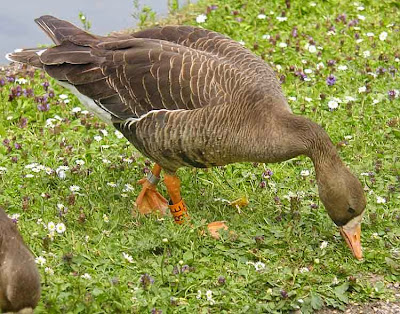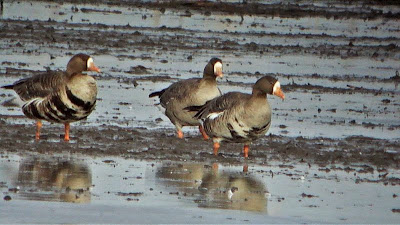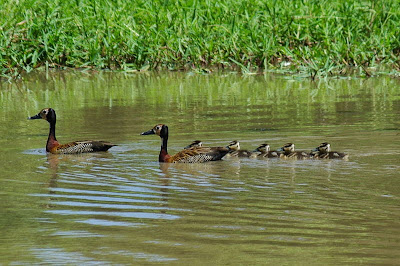The greater white-fronted goose (Anser albifrons) is a species of goose. The greater white-fronted goose is closely related to the smaller lesser white-fronted goose (A. erythropus). In Europe it has been known as simply "white-fronted goose"; in North America it is known as the greater white-fronted goose (or "greater whitefront"), and this name is also increasingly adopted internationally. It is named for the patch of white feathers bordering the base of its bill. But even more distinctive are the salt-and-pepper markings on the breast of adult birds, which is why the goose is colloquially called the "specklebelly" in North America.
Greater white-fronted geese are 64–81 cm (25–32 in) in length, have a 130–165 cm (51–65 in) wingspan and weigh 1.93–3.31 kg (4.3–7.3 lb). They have bright orange legs and mouse-coloured upper wing-coverts. They are smaller than greylag geese. As well as being larger than the lesser white-fronted goose, the greater white-fronted goose lacks the yellow eye-ring of that species, and the white facial blaze does not extend upwards so far as in lesser.
The male is typical larger in size, both sexes are similar in appearance—greyish brown birds with light grey breasts dappled with dark brown to black blotches and bars. Both males and females also have a pinkish bill and orange legs and feet.
Differences between European and Greenland birds
The appearance of European or Russian white-fronted geese, of the race albifrons and Greenland white-fronted geese, of the race flavirostris, differ in a number of ways. The Greenland white-fronted goose, in all plumages, looks darker and more 'oily-looking' than the European white-fronted goose, both at rest and in flight.
The following are the differences which apply to first-winter plumage:
Greater white-fronted geese are 64–81 cm (25–32 in) in length, have a 130–165 cm (51–65 in) wingspan and weigh 1.93–3.31 kg (4.3–7.3 lb). They have bright orange legs and mouse-coloured upper wing-coverts. They are smaller than greylag geese. As well as being larger than the lesser white-fronted goose, the greater white-fronted goose lacks the yellow eye-ring of that species, and the white facial blaze does not extend upwards so far as in lesser.
The male is typical larger in size, both sexes are similar in appearance—greyish brown birds with light grey breasts dappled with dark brown to black blotches and bars. Both males and females also have a pinkish bill and orange legs and feet.
Differences between European and Greenland birds
The appearance of European or Russian white-fronted geese, of the race albifrons and Greenland white-fronted geese, of the race flavirostris, differ in a number of ways. The Greenland white-fronted goose, in all plumages, looks darker and more 'oily-looking' than the European white-fronted goose, both at rest and in flight.
The following are the differences which apply to first-winter plumage:
- The mantle and scapulars of flavirostris have narrow, indistinct pale fringes creating a uniform appearance to the birds' upperparts, whereas albifrons has noticeable whitish fringes creating obviously barred upperparts
- The tertials of flavirostris have indistinct pale fringes, whereas these pale fringes are more noticeable on albifrons
- The lesser- and median-upperwing-coverts of flavirostris have narrow, indistinct pale fringes, creating a rather uniform appearance to the wing, whereas on albifrons, these fringes are prominent and broad, creating wing-bars
- The greater-coverts of flavirostris are dark grey, with a narrow white tip, forming a narrow wing-bar; on albifrons they are blue-grey, with prominent white tips, forming a bold wing-bar
- The flank-line is narrows and white on flavirostris, but broad and bright white on albifrons
- The tail of flavirostris is dark brown, with a very narrow white tip and sides; that of albifrons is dark grey, and the white tip and sides are at least double the width of the corresponding areas on flavirostris
- The bill of flavirostris is orange-yellow with a dark nail, compared with the bright pink bill of albifrons which has only a hint of dark on the nail; in addition the bill of flavirostris is longer and appears slimmer than that of albifrons
The belly-barring on adult birds is on average more extensive on flavirostris than on albifrons, but the individual variation in both forms renders this of limited use as an identification feature.
The bill of adult Greenland white-fronts are also orange-yellow at the base, but can be more pinkish-yellow on the outer-half, thus close in colour to European white-fronts; the colour difference is more easily determined in dull, flat light rather than bright sunshine.
The greater white-fronted goose is divided into five subspecies. The nominate subspecies A. a. albifrons breeds in the far north of Europe and Asia, and winters further south and west in Europe.
Three other restricted-range races occur in northern North America: A. a. gambeli in interior northwest Canada, and wintering on the coast of the Gulf of Mexico, slightly larger than the nominate form, Pacific white-fronted goose, A. a. frontalis and tule goose, A. a. elgasi, in southwest Alaska, largest and longest-billed of all, both wintering in California. All these races are similar in plumage, differing only in size.
The very distinct Greenland white-fronted goose, A. a. flavirostris, breeding in western Greenland, is much darker overall, with only a very narrow white tip to the tail (broader on the other races), more black barring on its belly, and usually has an orange (not pink) bill. It winters in Ireland and western Scotland.
Birds breeding in the far east of Siberia east to Arctic Canada, wintering in the United States and Japan, have been described as A. a. frontalis on the basis of their slightly larger size and a marginally longer bill. Another putative East Asian subspecies albicans has also been described. A 2012 study has found that frontalis and albicans do not merit subspecies status, the former being synonymised with gambelli and the latter with the nominate subspecies; this study found that these forms had been named on the wintering grounds from specimens whose breeding grounds were unknown.
Ecological studies in 2002 suggest the Greenland birds should probably be considered a separate species from A. albifrons. Of particular interest is its unusually long period of parental care and association, which may last several years and can include grandparenting, possibly uniquely among the Anseriformes.
The North American midcontinent birds of the subspecies A. a. gambeli—which in 2010 had a fall population of about 710,000 birds—breeds from the Alaska North Slope across the western and central Canadian Arctic. The Pacific white-fronted goose of the American Pacific coast, which in 2010 numbered approximately 650,000 birds, and the tule geese, which are estimated to number 10,000 birds, nest in western Alaska. The midcontinent geese gather in early fall on the prairies of western Saskatchewan and eastern Alberta, spending several weeks feeding before heading to wintering areas near the Gulf of Mexico, into northern Mexico. The Pacific birds migrate south down the Pacific coast, staging primarily in the Klamath Basin of southern Oregon and northern California and wintering, eventually, in California's Central Valley. The tule goose is somewhat rare and has been since the latter half of the 19th century, presumably it was affected by destruction of its wintering habitat due to human settlement.
In the British Isles, two races overwinter: Greenland birds in Scotland and Ireland, and Russian birds in England and Wales. They gather on farmland at favoured traditional sites, with a famous flock gathering at WWT Slimbridge, Gloucestershire, England. Greenland birds also overwinter in Ireland and from late September and through the winter months, Ireland is home to almost 50% of the Greenland population of white-fronted geese.
A. a. albifrons and A. a. flavirostis are among the taxa to which the Agreement on the Conservation of African-Eurasian Migratory Waterbirds (AEWA) applies.
Weather conditions are a key factor in the annual breeding success of white-fronted geese. In the Arctic, the window of opportunity for nesting, incubating eggs, and raising a brood to flight state is open briefly, for about three months. Arriving in late May or early June, white-fronted geese begin departing for fall staging areas in early September. This means that a delayed snowmelt or late spring storm can significantly reduce the birds' reproductive success.
The bill of adult Greenland white-fronts are also orange-yellow at the base, but can be more pinkish-yellow on the outer-half, thus close in colour to European white-fronts; the colour difference is more easily determined in dull, flat light rather than bright sunshine.
The greater white-fronted goose is divided into five subspecies. The nominate subspecies A. a. albifrons breeds in the far north of Europe and Asia, and winters further south and west in Europe.
Three other restricted-range races occur in northern North America: A. a. gambeli in interior northwest Canada, and wintering on the coast of the Gulf of Mexico, slightly larger than the nominate form, Pacific white-fronted goose, A. a. frontalis and tule goose, A. a. elgasi, in southwest Alaska, largest and longest-billed of all, both wintering in California. All these races are similar in plumage, differing only in size.
The very distinct Greenland white-fronted goose, A. a. flavirostris, breeding in western Greenland, is much darker overall, with only a very narrow white tip to the tail (broader on the other races), more black barring on its belly, and usually has an orange (not pink) bill. It winters in Ireland and western Scotland.
Birds breeding in the far east of Siberia east to Arctic Canada, wintering in the United States and Japan, have been described as A. a. frontalis on the basis of their slightly larger size and a marginally longer bill. Another putative East Asian subspecies albicans has also been described. A 2012 study has found that frontalis and albicans do not merit subspecies status, the former being synonymised with gambelli and the latter with the nominate subspecies; this study found that these forms had been named on the wintering grounds from specimens whose breeding grounds were unknown.
Ecological studies in 2002 suggest the Greenland birds should probably be considered a separate species from A. albifrons. Of particular interest is its unusually long period of parental care and association, which may last several years and can include grandparenting, possibly uniquely among the Anseriformes.
The North American midcontinent birds of the subspecies A. a. gambeli—which in 2010 had a fall population of about 710,000 birds—breeds from the Alaska North Slope across the western and central Canadian Arctic. The Pacific white-fronted goose of the American Pacific coast, which in 2010 numbered approximately 650,000 birds, and the tule geese, which are estimated to number 10,000 birds, nest in western Alaska. The midcontinent geese gather in early fall on the prairies of western Saskatchewan and eastern Alberta, spending several weeks feeding before heading to wintering areas near the Gulf of Mexico, into northern Mexico. The Pacific birds migrate south down the Pacific coast, staging primarily in the Klamath Basin of southern Oregon and northern California and wintering, eventually, in California's Central Valley. The tule goose is somewhat rare and has been since the latter half of the 19th century, presumably it was affected by destruction of its wintering habitat due to human settlement.
In the British Isles, two races overwinter: Greenland birds in Scotland and Ireland, and Russian birds in England and Wales. They gather on farmland at favoured traditional sites, with a famous flock gathering at WWT Slimbridge, Gloucestershire, England. Greenland birds also overwinter in Ireland and from late September and through the winter months, Ireland is home to almost 50% of the Greenland population of white-fronted geese.
A. a. albifrons and A. a. flavirostis are among the taxa to which the Agreement on the Conservation of African-Eurasian Migratory Waterbirds (AEWA) applies.
Weather conditions are a key factor in the annual breeding success of white-fronted geese. In the Arctic, the window of opportunity for nesting, incubating eggs, and raising a brood to flight state is open briefly, for about three months. Arriving in late May or early June, white-fronted geese begin departing for fall staging areas in early September. This means that a delayed snowmelt or late spring storm can significantly reduce the birds' reproductive success.
 |
| Anser Albifrons |
 |
| Greater White Fronted Goose Photos |
 |
| Three Greater White Fronted Goose Photos |

















































